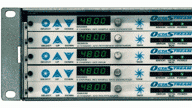Changing channels: Audio for DTV

Designers are hard at work creating new digital television systems that will fundamentally change each segment of the broadcast industry. During this period of transition, most professionals have focused most of their attention on managing video signals of various formats and data rates. What’s often overlooked are the challenges associated with implementing digital audio.
The OctaStream line consists of the DA5320 Mixer & Subframe Router, the DA5315 Variable Delay Compensator, the DA5325 Sample Rate Converter and the SG5605 Audio Reference Generator.
Interestingly, designing digital video signal layers is not very different from designing analog video signal layers. Timing considerations and constraints are similar and, in some instances, less strict. Of course, there are new technologies to implement that utilize servers and compression, but basic signal management schemes remain the same.
However, managing digital audio is far less understood. Digital audio, like video, is just data; data that needs to contain timing information in order for it to be understood and decoded. The ATSC standards for digital television include the use of Dolby Digital compression to allow the delivery of audio as mono, stereo, Pro-Logic or full 5.1 channel surround sound. But how will the program originator manage the six or eight channels of audio needed for this? How will the networks deliver it to the local broadcaster? In turn, how will the local stations manage these signals before finally encoding them as Dolby Digital for delivery?
These questions have given rise to Sigma’s OctaStream family of AES digital audio signal management products. The four initial products that make up OctaStream can all work independently, but collectively they comprise a solution designed to cost-effectively address the integration of AES and multichannel digital audio into the DTV environment.
The family includes the DA5320 mixer and subframe router, the DA5315 variable delay compensator, the DA5325 sample rate converter, and the SG5605 audio reference generator. These eight-channel units are designed to work together in a modular fashion so that stations can buy one, all or any combination and implement them as their needs dictate.
Each of these “modules” can also be used for independent AES inputs or phased multichannel streams. They are designed for the new S5000 signal management frame, which allows unrestricted access to all modules, provides several choices for external control and is capable of hot-swapping all modules and power supplies. The modules are also fully compatible with NVision’s NV500 enclosures, allowing them to be installed into existing NV500 frames.
Get the TV Tech Newsletter
The professional video industry's #1 source for news, trends and product and tech information. Sign up below.
Broadcasters don’t have to have eight channels of audio, but using the modules gives them the option of having eight channels. Also, at some point in the chain there will be eight channels of audio: six channels (or 5.1 surround sound mix) and support for legacy transmissions. In addition, these products are equipped to handle any function connected with ATSC signal management and transmission.
The reference generator allows them to slave to their house reference and OctaStream provides an eight-channel signal reference with IDs incorporated. Then, they’ll need to time what comes in, using the eight-channel sample rate converter. The incoming audio could be eight channels of a complete eight-channel set, independent stereo pairs, or it could be from non-video devices.
The variable delay compensator provides the ability to match the latency between video and audio. The most likely delay path is through the video chain, which offers another eight-channel device that’s programmable. Users can either slave all eight channels so they delay to compensate for the video delay or they can independently change the delay of the AES channel pairs.
There’s also an eight-channel mixer and channel swapper, which allows users to easily and inexpensively move signals around. The modules also provide the capability to adjust gains of eight independent channels in order to swap channels around in a process called channel shuffling. For example, this process would allow you to swap channels one and three and break them out of their original AES pairs.
All of the modules provide constant AES outputs, regardless of input presence, as well as automatically performing a fade to silence at the loss of an input and a fade to normal once an input recovers. This ensures that critical paths are not interrupted, and that upstream asynchronous switching errors are concealed.
Figure 1. Using OctaBus interface technology with the OctaStream system allows modules to share input signals and lends flexibility to audio management.
OctaStream also incorporates OctaBus, a proprietary TDM communications technology that allows eight modules to share their input signals via a single connection, providing each module with access to a total of 64 audio channels. (See Figure 1.) Interconnecting modules using this technology adds flexibility to audio management. Via this interface, 64 channels can be mixed, routed or retimed cost-effectively.
As the industry continues to move forward, maintaining phase coherence across audio channels and managing audio/video latency grows ever more essential. Thus, solutions like OctaStream with OctaBus are not only cost-effective, but scalable, and provide the level of flexibility that effective digital television systems require.
Nigel Spratling is the president of Sigma Electronics.
